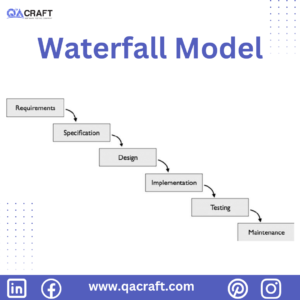11 Jul

What is a waterfall model?
The waterfall model is a linear-sequential approach to the software development life cycle. It consists of a series of phases, each of which must be completed before moving on to the next one.
The phases are as follows:
The waterfall model consists of several phases, including requirement gathering, design, implementation, testing, and maintenance. Each phase has its deliverables and milestones, and once completed, the team moves on to the next phase. The model is called a “waterfall” because each phase flows into the next one in a linear manner, like a waterfall.
Requirements Gathering:
The first phase of the waterfall model is requirements gathering. In this phase, the project team works with stakeholders to identify the project’s goals and objectives.
Design:
The second phase of the waterfall model. In this phase, the team uses the requirements document to create a detailed design of the software. The design includes information about the software’s architecture, interface, and data structures.
Implementation
The third phase of the waterfall model is implementation. In this phase, the team starts to write the actual code for the software. The implementation phase is the longest and most time-consuming phase of the waterfall model.
Testing
The fourth phase of the waterfall model is testing. In this phase, the team tests the software to ensure that it meets the requirements specified in the requirements document and is free from bugs.
Maintenance
The last phase of the waterfall model is maintenance. In this phase, the team maintains the software by fixing the issues that arise after it has been deployed and making updates as needed.

Advantages and Disadvantages of the Waterfall Model
Advantages
The main advantage of the waterfall model is that it is easy to understand and use. The linear approach makes it easy to plan and manage the project, and it is easy to see the progress being made.
Another advantage of the waterfall model is that it provides a clear structure for the project. Each phase has its own deliverables and milestones, which makes it easy to track progress and identify any issues.
The waterfall model is easy to understand. It follows a structured and sequential process, making it easier to plan and manage the project.
The model requires the upfront gathering of detailed requirements before starting development. This helps decrease uncertainty and ensure that the final product meets the specified requirements.
The model defines different phases, allowing for better control and progress tracking. It helps in identifying difficulties and addressing issues early in the development of the lifecycle.
The waterfall model emphasizes documentation at each phase, ensuring that there is a clear record of the project requirements, design, and development. This documentation is helpful for future maintenance and reference.
The sequential nature of the waterfall model enables the early identification of potential risks and issues. By addressing them in the early stages, it decreases the chances of major setbacks later in the project.
Disadvantages
One of the main disadvantages of the waterfall model is that it is not flexible. Once a phase is completed, it cannot be revisited without starting the entire process over again. This can lead to delays in projects and increased costs of projects.
Another disadvantage of the waterfall model is that it does not allow for changes in requirements. Once the requirements have been documented, they cannot be changed without starting the entire process over again.
Once a phase is completed and the project moves to the next phase, it becomes difficult to make changes or incorporate new requirements. This lack of flexibility can lead to inefficiencies and delays if changes are required later in the development process.
The waterfall model typically involves minimal customer involvement until the final product is delivered, this can lead to a mismatch between customer expectations and the actual product, as there is limited opportunity for feedback and iteration during development.
Testing and validation are usually performed at the end of the development process in the waterfall model. This means that any errors or defects may only be detected late in the cycle, making it more difficult and expensive to fix them.
The sequential nature of the waterfall model can result in longer development cycles, especially for large and complex projects. This can be a disadvantage in fast-paced environments where there is a need for quicker iterations and frequent releases.
The waterfall model assumes that all requirements can be identified and defined upfront, which is often not the case in real-world projects. It can lead to unrealistic assumptions and make it challenging to adapt to changing requirements or evolving project needs.
Conclusion
In conclusion, the waterfall model is a linear approach to software development that has its own set of advantages and disadvantages. It is best suited for projects that have well-defined and stable requirements and a fixed budget and timeline. To implement the waterfall model, you will need to follow a set of defined phases, including requirement gathering, design, implementation, testing, and maintenance. By avoiding common mistakes, you can ensure that your project is successful and meets the requirements of stakeholders.
Deepali works as a Software Development Engineer in Test, at QACraft, she is a computer science engineer with a degree of bachelor and has 3+Years of experience in the software industry as a Manual Tester and Automation Test Engineer. In her free time, she loves reading and podcasts.
Related Post
Leave a Comment Cancel reply
Categories
- Agile Testing
- Alpha Testing
- Android App Testing
- API Testing
- Automation Testing
- Banking Domain Testing
- Beta Testing
- cloud testing
- Corporate Life
- cross browser testing
- Cypress Testing
- desktop testing
- Difference
- Domain Testing
- E-commerce Website Testing
- E-learning App Testing
- End-To-End Testing
- Functional Testing
- Game Testing
- Healthcare Domain Testing
- Integration Testing
- Interview Questions
- ios App Testing
- Jenkins
- JIRA
- Katalon
- Manual Testing
- Mobile App Testing
- Monkey Testing
- Non-Functional testing
- Performance Testing
- Postman
- Regression Testing
- Salesforce Testing
- Sanity Testing
- security testing
- Selenium Testing
- Smoke Testing
- Software Testing
- Stability testing
- Static Testing
- Test Case
- Test Environments
- Test Scenario
- Test Script
- TestRigor
- Web Application Testing
© Copyright 2025 QACraft Pvt. Ltd. All rights reserved.
Contact : +91 9157786796




deepali